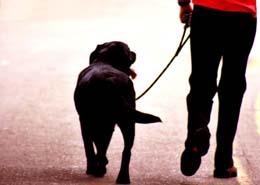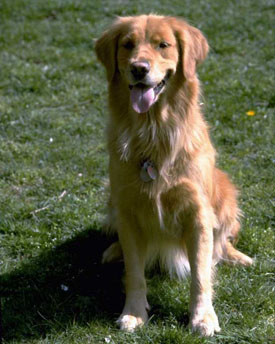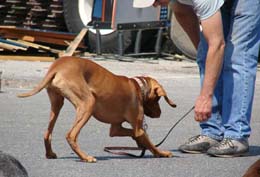Here is your 4th training lesson.
Continue to Introduce Obedience in Dog Training
Skills are developed by repetition. Repeat each skill 4 to 6 times to ensure patterns are being set.
This week we introduce the down stay. This is one of the most use commands if you take your dog with you to public places or with you on day trips. Anytime you are busy loading or unloading the car or even if you need to run into a store for a few minutes, the down stay comes in mighty handy.
Sit stay is more of a stand by exercise. Very helpful for waiting to cross the street or greeting people. The sit stay is also the position that we really work on building our dogs attention during distraction training. Your dog should sit and continue to look at you no matter what is going on around them.
Lesson 4 Practice the following turns: Turn against your dog (U-Turn to the left, toward your dog) Begin walking with your dog in the neutral position. Hold the leash in your right hand. Stop. Step back with left leg and turn. Simultaneously tug on the leash, and command "Heel". As you do this, bring the leash behind your back and switch to the left hand. Signal the dog's position and praise the dog if he obeys. Continue forward. Switch the leash to right hand. Left turn about Begin walking your dog. Switch the leash to your left hand. Slow down. Place your left foot in front of the dog as you signal the stay position. Pivot in front of the dog and go back. Signal the dog's position.
|
|
|
Practice the following two stays: Sit-Stay From the neutral position, command the dog to "Sit". Praise the dog if he obeys. To correct, say "No" as you tug the leash and command the dog to "Sit" once again. Give the hand signal for "Stay". Pivot around to the front of the dog and walk backward to the end of the leash, while commanding the dog to stay. (Use both verbal and hand signals.) Hold the leash loosely in the left hand. Take the right hand and place underneath the leash with the fingers under the leash and the thumb over the leash. If the dog moves from his position, say "No" as you move the right hand upward to give the leash a tug. Command him again to "Sit, Stay" and praise. (The upward movement with the hand is the signal for sit.) Have him hold this position for a minute or so. At the end of the work session, and from the "Sit, Stay" position, ask the dog to come. Reel in the leash as you move backward and command him to "Sit" in front of you. Pet and praise.
|
Down the dog (Down-Stay) Standing beside your dog from the heel position or neutral position, switch the leash to the left hand. Take your left hand, in a palms-down position, and place on the leash as close to the dog as possible and gently push down toward your left heel as you command the dog "Down". If the dog resists, you may use your right hand to gently push his front legs down. Command him to "Stay". Hold leash in your left hand. Praise. Pivot in front of the dog. Stay close. Have him "Stay" for a minute or so. To correct: command "No" as you tug in a downward movement, then command "Stay" and praise.
|
|
freeclass4@dogskool.org
Practice these skills several times a day throughout your training course.









